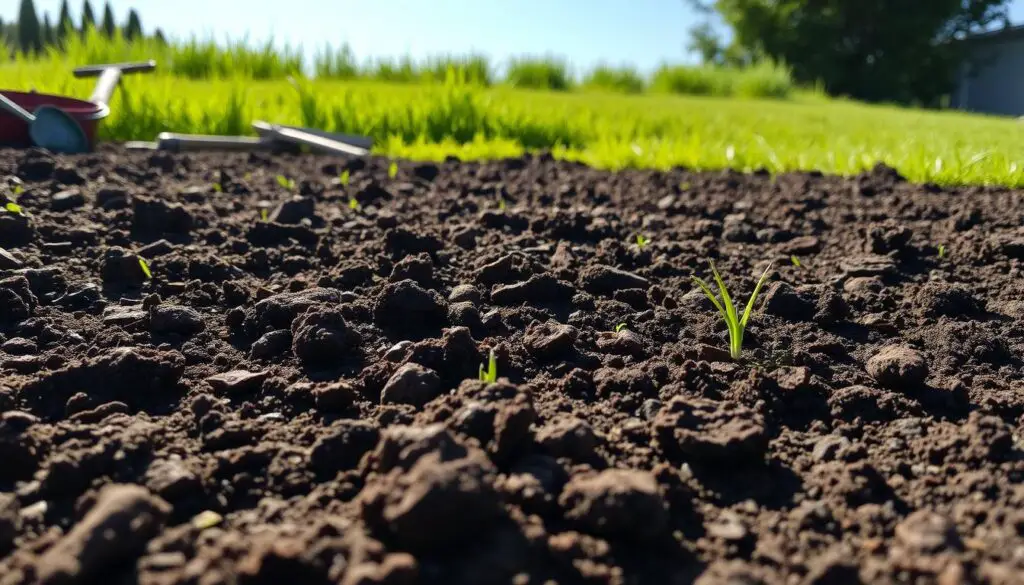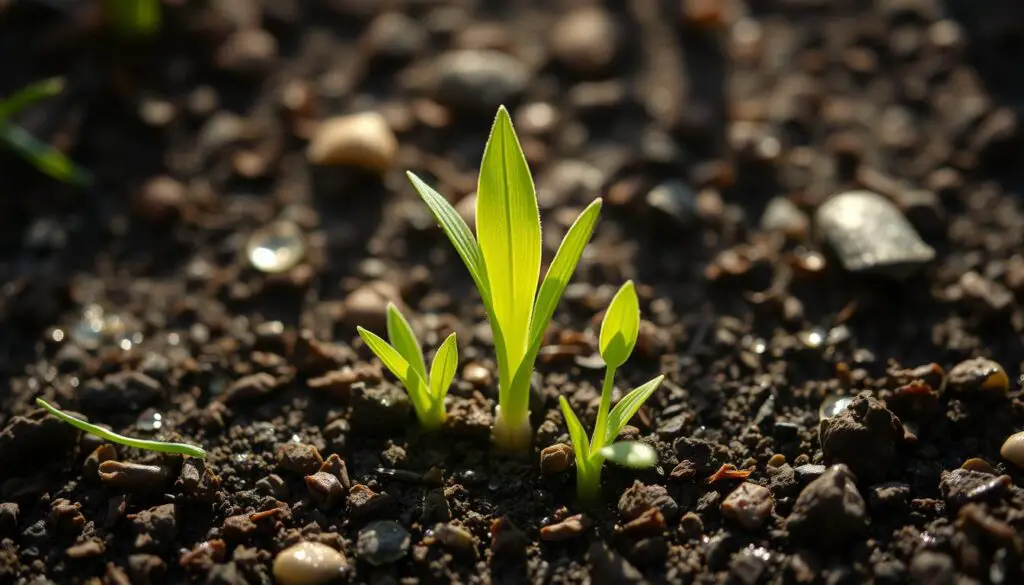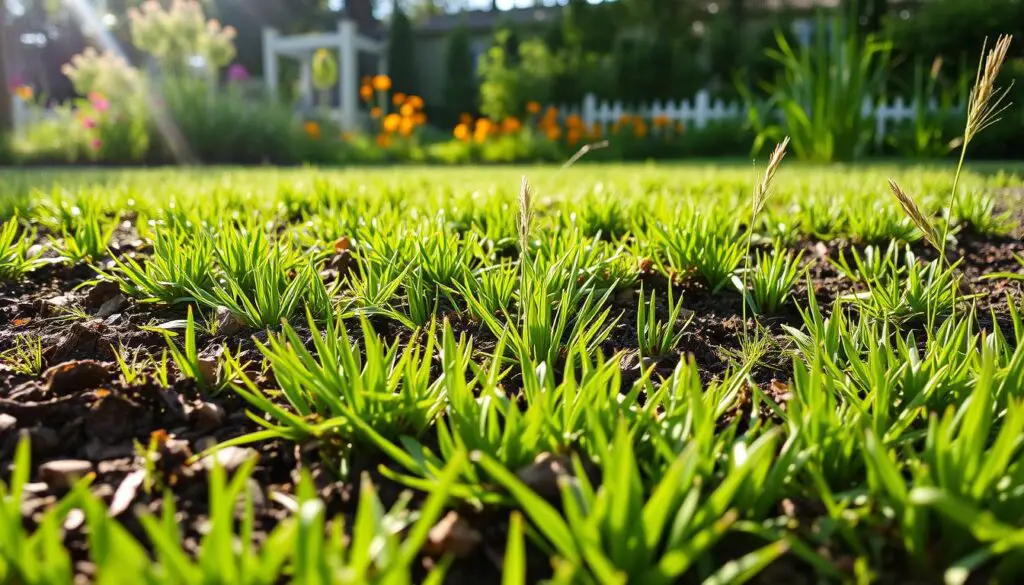When to Plant Grass: The Best Time of Year to Plant Grass Seed

Wondering when to plant grass for your lawn? It’s all about the right season and soil conditions for your grass type.
Did you know the last five weeks of summer to early autumn are the best for planting grass seed? This is the prime time for cool-season grasses like perennial ryegrass and Kentucky bluegrass. If you plant at the right moment, your lawn can become lush and green.
If you’re wondering when to plant grass, late summer to early fall is the best time for cool-season grasses like Kentucky bluegrass and perennial ryegrass.
As a homeowner, I’ve found the best planting time depends on your grass type and local weather. In this article, I’ll show you the best planting times for cool-season and warm-season grasses. This way, you can make your lawn look perfect.
When to Plant Grass: The Best Time of Year to Plant Grass Seed
- Late summer to early fall is the ideal time to plant cool-season grasses like perennial ryegrass and Kentucky bluegrass.
- Cool-season grasses can take 1-2 weeks (perennial ryegrass) or 4-6 weeks (Kentucky bluegrass) to fully emerge when seeded in late summer or early fall.
- Early spring planting can also work for cool-season grasses in mild climates, but may face weed competition.
- Warm-season grasses like bermuda grass should be planted in late spring to early summer when soil temperatures are consistently above 25°C (77°F).
- Proper soil preparation, seeding techniques, and ongoing maintenance are crucial for the success of any new grass planting project.
Understanding Cool-Season vs. Warm-Season Grasses
Knowing the difference between cool-season and warm-season grasses is key for a healthy lawn. These grass types grow differently and need different care. This knowledge helps gardeners plan their landscaping better. The ideal when to plant grass depends on your climate and the type of grass you’re using, so timing is key to success.
Cool-Season Grasses
Cool-season grasses like Kentucky bluegrass and fine fescues grow best in cooler months. They start growing in late winter and slow down in hot summers and cold winters. These grasses do well in areas with moderate weather and plenty of rain.
Warm-Season Grasses
Warm-season grasses, including Bermudagrass and Zoysiagrass, thrive in summer and go dormant in cold weather. They grow new leaves in late spring to early summer. This makes them perfect for warmer places with hot summers.
| Cool-Season Grasses | Warm-Season Grasses |
|---|---|
|
|
Knowing if your grass is cool-season or warm-season is crucial. It helps with lawn care and management. By choosing the right grass for your climate, you can have a beautiful lawn that shows off your area’s unique charm.
The Ideal Time to Plant Cool-Season Grass Seed
Timing is key for a lush, healthy lawn. Homeowners should plant cool-season grass in late summer to early fall, or early spring. Knowing when to plant grass can make all the difference in creating a lush, green lawn that thrives year-round.
Late Summer to Early Fall
For cool-season grasses like Kentucky bluegrass and tall fescue, seed from mid-August to early October. In the transition zone, seed between Labor Day and late October. This timing helps the grass grow strong before winter.
Early Spring
For the best results, pay attention to the soil temperature and plant your grass at the right time, which is usually in late summer or early fall.
Seeding in early spring, from April 1 to May 15, is also good. The soil should be 50-60°F. This method works well in mild winter areas, with the right soil and moisture.
The best time to plant cool-season grass varies by location and lawn. Knowing the lawn establishment timeline helps make the right choice for long-term success.

The Best Time to Plant Warm-Season Grass Seed
The best time to plant warm-season grass seed is in late spring to early summer. Warm-season grasses like Bermudagrass, bahiagrass, and Zoysiagrass grow best when the soil is 65-75°F. This usually happens when the air is about 80°F.
In the transition zone, wait until May to plant your warm-season grass. This avoids frost damage. It lets the seedlings grow strong before the cold months.
Optimal Conditions for Warm-Season Grass Seeding
Warm-season grass seeds germinate in 7-30 days. This depends on air temperature and humidity. Planting in late spring to early summer gives your grass the best chance to thrive.
| Grass Type | Ideal Planting Time | Germination Time |
|---|---|---|
| Bermudagrass | Late Spring to Early Summer | 7-21 days |
| Bahiagrass | Late Spring to Early Summer | 10-28 days |
| Zoysiagrass | Late Spring to Early Summer | 14-30 days |
Planting your warm-season grass at the right time ensures a lush, healthy lawn. This approach helps you achieve the success you want in grass planting.
Preparing Your Lawn for Grass Seeding
Starting a lush lawn needs careful soil prep. Before seeding, remove thatch, aerate, and level the ground. These steps help your new grass grow well.
Removing Thatch and Aerating Soil
Thatch is a thick layer of dead and living plants that blocks seed contact. Use a dethatching rake or power dethatcher to remove it. Then, aerate the lawn to improve drainage and soil health.
Leveling and Amending Soil
For a uniform lawn, level the soil first. Use topsoil or soil amendment to fill in low spots. This ensures even seed planting.
Test the soil pH and adjust it to 6.0 to 7.0. Use limestone for acidic soil or sulfur for alkaline to create the best growing conditions.
| Grass Type | Germination Time |
|---|---|
| Perennial Ryegrass | 3-5 days |
| Fescue | Around 10 days |
| Kentucky Bluegrass | 2-3 weeks |
| Warm-Season Grasses (Centipede, Bermuda, Zoysia) | Over 1 month |
By carefully preparing your lawn for grass seeding, you’re setting up a healthy lawn for the future. Proper soil preparation and lawn establishment timeline give your grass seedlings the best start.

Best Time to Plant Grass
As a homeowner, having a lush, healthy lawn is key. Planting grass seed at the right time is crucial. The best planting time varies by grass type and local climate.
Following a grass planting schedule based on your local climate ensures the best chance for healthy, strong growth.
Cool-season grasses like Kentucky bluegrass, tall fescue, and perennial ryegrass do best in late summer to early fall. This lets the grass grow strong roots before winter. Homeowners in Zone 6 and below should seed their cool-season grass from mid-August to mid-October.
Warm-season grasses like bermuda grass, zoysia, and St. Augustine grow well in warmer climates. Plant these in late spring to early summer when the soil and air are warm. These grasses do best in Zone 7 and above.
| Grass Type | Best Planting Time | Climate Zones |
|---|---|---|
| Cool-Season Grasses | Late Summer to Early Fall | Zone 6 and Below |
| Warm-Season Grasses | Late Spring to Early Summer | Zone 7 and Above |
Proper soil preparation is key for growing a healthy lawn. This includes removing thatch, aerating the soil, and leveling uneven areas. With the right timing and preparation, you can create a lush, green lawn that will last for years.
A grass planting schedule helps homeowners determine the ideal time to plant cool-season and warm-season grasses for optimal results.
Overseeding an Existing Lawn
Overseeding your lawn can make a big difference. It involves spreading new grass seed over your current lawn. This fills in bare spots and boosts your lawn’s health. But when is the best time to overseed? It depends on your grass type.
For cool-season grasses, overseed in the late summer to early fall. This is when it’s cooler and your grass grows well. It helps the new seedlings grow strong before winter. On the other hand, overseed warm-season grasses in the late spring to early summer.
Before you start, aerate your lawn. Aerating makes holes in the soil for better seed contact. Use a seed spreader to spread the seed evenly. Aim for 16 seeds per square inch of soil.
| Grass Type | Best Overseeding Season |
|---|---|
| Cool-Season | Late Summer to Early Fall |
| Warm-Season | Late Spring to Early Summer |
Remember, consistent moisture is crucial for new seedlings. Water your lawn every day, best in the morning. This way, overseeding can make your lawn lush and healthy.
Watering and Caring for New Grass Seedlings
Watering new grass seed right is key to its success. Keep the soil moist but not too wet until the grass grows. It might need water every day or more during the germination period, which can last from 5 to 30 days.
Once the grass grows, switch to deeper, less frequent watering. This helps the roots grow deep, making your lawn strong and healthy. A good watering schedule for a grown lawn is three times a week, for 20 minutes each time, adjusting for weather.
Proper Watering Techniques
Water your new grass in the early morning or late afternoon. This is when it’s cooler and water evaporates less. It keeps the soil moist, perfect for the grass seed germination period and lawn establishment timeline.
Don’t underwater or overwater, as it can harm your grass. Watch the soil moisture and adjust your watering to keep your new grass happy.
| Grass Type | Germination Period |
|---|---|
| Bermudagrass | 10 – 30 days |
| Centipedegrass | 14 – 21 days |
| Fine Fescue | 7 – 14 days |
| Kentucky Bluegrass | 14 – 30 days |
| Perennial Ryegrass | 5 – 10 days |
| St. Augustinegrass | 10 – 30 days |
| Tall Fescue | 10 – 14 days |
| Zoysiagrass | 14 – 21 days |
Keep in mind, your grass’s watering needs can change based on soil, weather, and grass type. By following these tips and adjusting as needed, you’ll have a beautiful lawn for years.

Preventing Weed Competition
Creating a lush lawn from seed is more than just planting. It also means fighting weeds. Weeds compete for nutrients, water, and sunlight that your grass needs. But, there are ways to keep weeds away and help your grass grow strong.
Start by using pre-emergent herbicides before you seed. These products stop weed seeds from growing. Also, pulling weeds by hand is crucial, mainly in the first few months. This method keeps weeds from taking over and harming your grass.
Overseeding is another effective strategy. By adding more grass seed, you make your lawn denser. This makes it harder for weeds to grow. Over time, your lawn can become lush and weed-free, needing less care.
| Weed Control Strategy | Benefits | Drawbacks |
|---|---|---|
| Pre-emergent herbicides | Prevents weed germination, gives grass a head start | Careful timing required, can potentially harm new grass |
| Hand-pulling weeds | Removes weeds completely, no chemicals | Labor-intensive, must be done regularly |
| Overseeding | Creates a denser, more competitive lawn | Requires additional time and effort |
To stop weeds, make your lawn healthy and strong. Use these strategies and follow lawn care tips. This way, you can have a lush, weed-free lawn that everyone will admire.

“The best offense is a good defense when it comes to weeds – by giving your new grass the best possible start, you can prevent them from becoming a problem in the first place.”
Choosing the Right Grass Seed Variety
When you’re planting a new lawn or adding to an old one, picking the right grass seed is key. Cool-season grasses like Kentucky bluegrass and fescues do well in cooler areas. Warm-season grasses, including Bermuda and Zoysia, are best for warmer places.
When to plant is also important. Spring and fall are the best times because the weather is mild and there’s plenty of moisture. This helps new grass grow strong. Trying to plant in the hot summer can be tough for young grass.
| Grass Seed Variety | Climate Suitability | Water Requirements |
|---|---|---|
| Kentucky Bluegrass | Cool-season, Northern Regions | Up to 30% less water than ordinary grasses |
| Tall Fescue | Cool-season, Drought-tolerant, East of Cascades | Thrives with less water |
| Bermuda Grass | Warm-season, Southern Regions | Faster germination and establishment with Pennington Smart Seed Mix |
| Zoysia Grass | Warm-season, Southern Regions | Slower growth but highly drought-resistant |
By choosing the right cool-season grass varieties or warm-season grass varieties, you can get a lush, healthy lawn. This will last for many years.
“Choosing the appropriate grass type will ensure your new lawn establishes and thrives.”
Climate Factors Affecting Grass Planting
Timing is everything when it comes to planting grass seed. The best time to plant varies by climate zone. Knowing the difference between cool, transition, and warm zones is crucial for a healthy lawn.
Knowing your grass planting schedule can make all the difference in creating a lawn that thrives year-round. Planting at the optimal grass seeding time helps your grass establish strong roots before the season changes.
Cool vs. Transition vs. Warm Zones
Cool-season grasses like Kentucky bluegrass and tall fescue do best in late summer to early fall. This time offers cooler temperatures and plenty of moisture. It helps these grasses grow strong roots before winter.
Warm-season grasses, such as Bermudagrass and Zoysiagrass, prefer planting in late spring to early summer. They need soil temperatures above 80°F to grow well.
For those in transition zones, planting times need to be adjusted. By considering your local climate and the right grass types, you can have a lush lawn all year.
Understanding climate factors is key to a beautiful lawn. Whether you’re in a cool, transition, or warm zone, proper timing is vital. It makes a big difference in your lawn’s health and look.
Creating a Lush, Healthy Lawn
Creating a lush, healthy lawn takes careful planning and ongoing care. Plant grass seed at the right time for your area and grass type. Follow best practices for soil, watering, and weed control to achieve a beautiful lawn.
Regular mowing, fertilizing, and overseeding are key to keeping your lawn healthy. These steps help your grass look its best.
Knowing when to plant is crucial for a successful lawn. Cool-season grasses like Kentucky bluegrass do well in early fall or spring. Warm-season grasses, such as zoysia, thrive in late spring or early summer.
Soil preparation is vital for a healthy lawn. Aeration, leveling, and amending help seeds grow well. Use a spreader to spread seed evenly at 2 to 3 pounds per 1,000 square feet.
By following these tips and watching out for weeds, pests, and diseases, you’ll have a lawn everyone will admire. Enjoy your beautiful lawn for many years.
FAQ
When is the best time to plant grass seed?
What are the differences between cool-season and warm-season grasses?
When is the best time to plant cool-season grass seed?
When is the best time to plant warm-season grass seed?
How do I prepare my lawn for grass seeding?
What is the best time to overseed an existing lawn?
How should I water newly planted grass seed?
How do I control weeds when establishing a new lawn?
How do I choose the right grass seed variety for my lawn?
Source Links
- https://www.greenacelawncare.com/blog/when-is-the-best-and-worst-time-to-seed-your-lawn/
- https://extension.illinois.edu/blogs/grasses-glance/2022-05-23-understanding-cool-season-and-warm-season-grasses
- https://www.highcountrygardens.com/content/gardening/warm-season-grass-vs-cool-season-grass
- https://savvygardening.com/how-to-plant-grass-seed/
- https://scotts.com/en-us/lawn-care-101/planting-grass-for-a-new-lawn.html
- https://www.bhg.com/how-to-plant-grass-seed-7097100
- https://scotts.com/en-us/lawn-care-101/fall-is-the-best-time-to-seed-and-feed.html
- https://scotts.com/en-us/how-to/how-to-overseed-a-thin-lawn.html
- https://www.pennington.com/all-products/grass-seed/resources/overseeding-a-key-to-beautiful-lawns
- https://lawnlove.com/blog/how-long-to-water-new-grass-seed/
- https://apluslawn.com/blog/here-is-the-ideal-watering-schedule-for-a-newly-seeded-lawn/
- https://www.terra-lawn-care.com/best-time-to-plant-grass-seed/
- https://www.realsimple.com/the-best-time-to-plant-grass-seed-for-a-greener-lawn-8403715
- https://www.pennington.com/all-products/grass-seed/resources/recommended-grasses-for-regional-climates
- https://blog.davey.com/best-time-to-plant-new-grass-seed-pros-and-cons-for-each-season/
- https://www.terra-lawn-care.com/when-to-plant-grass-seed/
- https://www.architecturaldigest.com/gallery/how-to-plant-grass-seed
- https://pittsburghearthday.org/everything-you-need-to-know-about-growing-a-lush-organic-lawn/

